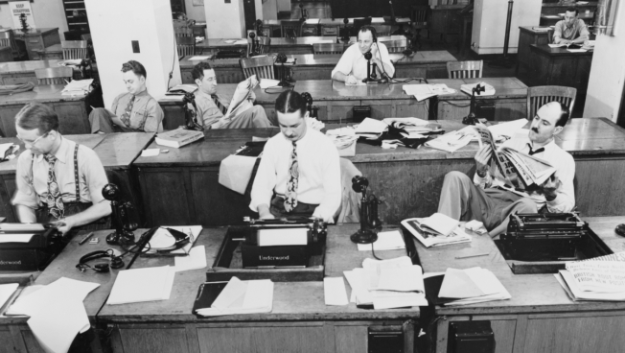
New York Times newsroom, 1942. Photo via Wikipedia.
Previously published at WGBHNews.org.
Editor & Publisher, a trade magazine that covers the newspaper business, posted a story last week predicting a startling technological change in the way we consume news. Believe it or not, it would involve grinding trees into pulp, transforming that pulp into paper, printing news articles, photos, and ads on that paper, and then loading the finished product onto trucks so that it could be delivered hither and yon.
“With the saturation of news, the toxicity of online harassment, and the amount of poor Web experiences, readers will soon want to come back to print,” wrote Nu Yang in an article headlined “As Digital Fatigue Sets In, Readers are Waking Up to Newspapers.”
Yang’s yearnings aside, print newspapers are no more likely to come back than the proverbial horse and buggy. Yes, they have proved more enduring than we might have expected 10 years ago, and Yang may be right they they’ll persist as “a premium, boutique product” for some time to come.
And the shortcomings of digital news that Yang describes are real enough. Too much information really does leave us feeling overwhelmed. Ad-blocking software is depriving digital news publishers of one of their very few routes for paying for the journalism they produce.
At root, though, Yang’s article represents little more than an assertion that because the post-print era has proved disastrous for the economics of news, then the answer must be to dial back the clock.
I wish I could be more optimistic about the road in front of us. In January I sketched out a starkly dystopian future for newspapers headlined “Print Is Dying, Digital Is No Savior: The Long, Ugly Decline Of The Newspaper Business Continues Apace.” Most of it had to do with the collapse of advertising-funded news.
Recently Nicco Mele, former senior vice president and deputy publisher of the Los Angeles Times and the incoming director of the Shorenstein Center on Media, Politics and Public Policy at Harvard’s Kennedy School, spoke at a Shorenstein seminar and outlined just how grim the advertising situation has become. Consider some figures he offered:
- The cost of a full-page weekday ad in the print edition of the LA Times, reaching 500,000 people, is about $50,000.
- The cost of an ad on LATimes.com to reach the same 500,000 people is about $7,000.
- The cost of an ad reaching 500,000 people that’s served up by Google and appears on LATimes.com might be as little as (are you sitting down?) $20.
“Digital advertising rates … have done nothing but decline for a decade, and they’re only going to keep declining,” Mele said, “because Google has basically arbitraged the price of advertising to such a bargain basement.”
One possible solution, Mele added, is for Google and Facebook to pay for the news content they make so much use of. But there are obvious problems with that, starting with the fact that Google and Facebook don’t want to pay, and that news organizations don’t dare withdraw from such massive distribution platforms.
A more promising possibility is to charge digital advertisers for time spent with an article rather than on how many times people click. The Financial Times is one of a growing number of news organizations now trying out this new model. “The only way you can actually look at the amount of value someone’s placed on content is how much time they’re spending with it,” the FT’s Brendan Spain was quoted as telling the International Business Times.
Given the challenges facing news organizations trying to get by with digital advertising, many newspapers in recent years have switched from free websites to an online-subscription model. Yet here, too, success has been limited.
The New York Times reported last week that it now has 1.2 million digital subscribers, which is far more than any other general-interest newspaper. But because print and online advertising revenues continue to fall, the paper lost $16 million during the first quarter of 2016.
The New York Post has reported that the Times may lay off hundreds from its newsroom of 1,300 people later this year—and though executive editor Dean Baquet denied it, Emily Jane Fox recently observed in Vanity Fair that on other occasions Baquet has acknowledged the need to get smaller (as it recently did by eliminating 70 jobs in Paris).
Given all this, it’s understandable that some people in the newspaper business are nostalgic for print. You can charge quite a bit. It’s finite and self-contained, which means that the advertising has maintained some value. And a lot of people like their print newspaper.
A lot—but not enough. The paid print circulation of virtually every newspaper continues to plummet. Overall, print advertising revenues dropped from about $47 billion in 2004 to about $16 billion in 2014, and there’s no bottom in sight. The digital share of that total has been stuck just north of $3 billion since 2007.
Back to the Future was a fun movie—but it was also a fantasy. In the search for a sustainable business model for journalism, there is no going back to print. Nor is there any substitute for the hard and painful work of experimenting in the hopes that a new idea or a combination of new ideas will stop the financial slide.
Discover more from Media Nation
Subscribe to get the latest posts to your email.
